Robert Opron
Robert Opron (born 22 February 1932) is a French automotive designer. Over the course of his career he worked for several different automobile brands, and many of his designs went into full production. He is best known for his work at Citroën, which he joined in 1962 and where he became Responsable de Style, head of the design department, in 1964.[1]
Robert Opron | |
|---|---|
| Born | 22 February 1932 (age 88) Amiens, France |
| Nationality | French |
| Occupation | Car designer |
Biography
Opron was born in Amiens in Picardy, France. His father was in the military and received several postings to locations in French Colonial Africa, so Opron grew up in places like Algeria, Mali and Abidjan.[2]
At 18 Opron contracted tuberculosis, and had to spend time in a sanatorium.[3] He returned to France in 1952 and enrolled in the École des Beaux-Arts in Amiens; one year later he transferred to the École nationale supérieure des Beaux-Arts in Paris.[4] He studied architecture under Auguste Perret.[2][5] Altogether Opron spent eight years studying architecture, painting, and sculpture.[6]
At age 21 he married Geneviève Mercier.[2] In the early 1950s Opron's interest in aircraft led him to take up flying, including acrobatic flying.[4]
In 1952 Opron began his professional career as a machine designer for the Compagnie Nationale des Sucreries in Ham in the Somme.[4] In 1954 he was hired by aircraft builder Société Nationale de Constructions Aéronautices du Nord.[4] He specialised in cockpit design, and worked on the Nord Noratlas aircraft.
Opron began working at Simca in 1958 at age 26.[7] His department was eliminated in 1961, and Opron received a two-year severance payout, but with a non-compete clause that prevented him from moving to another automaker.[8] Instead Opron went to Arthur Martin, a company that produced housewares and home appliances, where he became Director of Style.[9][10][11] Opron returned to automotive design with Citroën in 1962.
Over the course of his career Opron became known for balancing a collaborative, team-based approach to design with creative input from individuals.[12] He finally retired from design work in 2001.[4][8]
Awards and recognition
Opron was one of twenty-five designers nominated for the 1999 Car Designer of the Century competition.
A celebration of his work, OPRON 50 Years of Style, was held on 11 May 2002 in Verrières-le-Buisson on the occasion of his 70th birthday.[13][9]
Opron received Car Design News' Lifetime Achievement Award in 2016.[3]
The Carlisle Import & Performance Nationals of August 14–16 2020 is scheduled to include a featured display titled: "Cars of Robert Opron".[14]
Design history
The dolphin, the leopard, the swift, they each move at a speed consistent with their environment, each using a minimum of energy. What a great lesson for a stylist.
— Robert Opron, [15]
All Opron’s car designs have an organic wholeness as if they have been grown or shaped by the forces of wind, light, scale and structure. Many agree that one of the signatures of an Opron design is the way it will catch the light, and that it has a dynamic graphical element – movement being intrinsic in its shape even at rest.
Simca
Having joined Simca in 1958, his first significant project for them was designing the 1959 Simca Chambord Présidence V8 cabriolet used by French president Charles De Gaulle[4]
In 1959 Opron unveiled the futuristic Simca Fulgur concept car.[17] This bubble-topped design was Opron's response to a challenge from the magazine Journal de Tintin to design a car for the 1980s. The magazine supplied a list of anticipated standard features that included radar obstacle detection and gyroscopic stabilisation. Opron consulted with an astrophysicist friend to help integrate these not-yet realised concepts into the car.[10]
While at Simca he sketched out a two-box hatchback that caught the attention of Fiat's designers. This sketch eventually led to the Simca 1100.[4][18][2][19]
Another sketch by Opron at Simca has been suggested to have been the original concept for what later became the Renault Espace.[2] Others dispute this claim, and the design of the Espace is generally credited to Fergus Pollock.[20] In the late 1970s Matra designer Antoine Volanis addressed the need for a replacement for the Matra Rancho by designing an MPV using Simca parts and with input from Opron.[21] This design was presented to PSA management in 1979 as "Project P16", but did not reach production. Opron was at Renault throughout most of the Espace's development and for one year after sales started.
Citroën
In 1962 Mme. Opron-Mercier noticed an advertisement in Le Monde saying that an "Important industrial group" was looking to hire an experienced designer.[15] Opron responded to the ad, and was directed to report to the Quai de Javel, the home of Citroën. The personnel manager asked Opron to return later that day to the Bureau d'Études on the Rue du Théâtre to meet with Flaminio Bertoni, Citroën's chief designer and originator of the 2CV and DS.
When Opron arrived for the meeting with Bertoni, the older man asked to see Opron's portfolio of drawings. Opron recalled that Bertoni "threw them on the floor, poking them with his cane and stated that he did not think much of them."[15] Opron collected his drawings and indicated that he found Bertoni's behavior unacceptable, to which Bertoni replied "I do find you interesting though!". Opron left, vowing to never work for such a man. Three weeks later, he received a letter of appointment from Citroën.[7]
Opron joined Citroën’s Bureau d’Études in 1962. For the first three months he worked in the "Méthodes" section.[15]
Opron became Citroën's Responable de Style, or chief stylist, in 1964 following the death of Bertoni.[9]
Opron was tasked with developing a replacement for the 2CV, which evolved into the 1965 Citroën G-Mini design study.[22]
In 1965 Citroën launched new lines of 3.5–8.0 t (4–9 short tons) trucks; the 350 and 600 series that earned the nickname Belphégor for their unique cab design. The trucks were designed by Bertoni and Opron.[23][24][15]:176, 189
Opron began working on the second restyling of the Citroën DS as early as 1963 with Projet D29. His "Nouveau Visage" (new face) front appearing on the 1968 model year DS was a four-headlamp design with two lamps on each side under glass covers that blended with the body's lines. The inner headlamp on each side pivoted with the steering wheel, while the outer lamps were self-leveling.
In 1967, having abandoned the ambitious Projet F begun by Bertoni and taken over by Opron, Citroën initiated a competition for a new mid-range model that pitted Opron and the Bureau d'Études against Giorgetto Giugiaro and Italdesign.[18] Both teams submitted designs for front wheel drive 3- and 5-door cars powered by flat-four engines. Opron's proposal carried the day, and his Project G eventually became the GS released in 1970.[25][26] Some have claimed that Opron based the GS' shape on the Pininfarina Austin 1800 Aerodinamica Berline of 1967.[27] Others assert that, while it may have been influenced by the Italo-English concept car, Opron's design was an independent work, and point out that Citroën has never acknowledged any link.[16]:322–324[28][29] Giugiaro's rejected design was taken up by Alfa Romeo and developed into the Alfasud.[18]
In 1968 Citroën opened a new Centre d'Études at Vélizy, France. Opron oversaw the arrangements for the move, which was completed progressively over several years.[15]
Opron refreshed the Ami 6 to create the Ami 8 of 1969.[30][31] He also led the team that developed the Citroën M35, a two-door fastback based on the Ami 8 chassis that was powered by a single rotor Comotor engine.[16] Production ran from 1969–1971, and although 500 M35s were planned to be built, the total number is believed to be just more than half that.
The first completely new model of the Opron era, and the car he is most closely associated with, was the SM. Assigned the development name Projet S, the original goal was to produce a racing car suitable for Le Mans. Through the influence of Opron and Pierre Bercot, Citroën's managing director, it evolved from a racing car into a premium model in the old Grand Routier tradition.[32]
The SM team, which included Jean Giert, built a full-scale model in the Bureau d'Études workshops on the Rue du Théâtre, making the SM the last model developed in this location before the last of the style department moved to their new location in Vélizy.[33]
A design for a possible GS-based coupé progressed to the full-scale model stage.[26] The car was to be built by Ligier when their contract to assemble the SM expired in 1974–75 but did not go into production.
The project that was Opron's personal favorite was also his last design for Citroën.[3][34] Initially called Projet L, the result was the CX, which debuted in 1974 as the successor to the DS.
When Citroën declared bankruptcy in 1974, the French Government stepped in and arranged a merger of Citroën with Peugeot. Opron left shortly after this.[9]
Renault
In 1975 Opron started work at Renault after reportedly being the target of an executive search by them.[3] For his new employers he led the redesign of the Alpine A310, a project that stylist Peter Stevens was also involved in.[35] The original 4-cylinder A310 was modified to accommodate the V6 PRV engine, and to address some aerodynamic deficiencies of the original shape.
Opron developed a design for an ultra-compact city car called the Véhicule Bas de Gamme (VBG), or Entry Level Vehicle.[36] He was also involved in the Vesta II concept car of 1987, along with designer Gaston Juchet.[37]
Opron's designs at Renault included the Renault Fuego sports coupé of 1980, as well as the Renault 9 and 11, with the 9 sedan released in 1981 and the 11 hatchback in 1983.[38][39] Opron worked with AMC's Dick Teague to adapt the 9 and 11 models to the American market, where they were sold as the Alliance and Encore respectively.[40]
Opron's tenure at Renault was marked by extensive collaborations with other well-known designers and carrosserie.[4][41] Marcello Gandini influenced the shape of the 25 of 1983, and produced the shape for the Super Cinq in 1984.[42][43] An association with Giugiaro and Italdesign resulted in the Renault Gabbiano of 1983, and later the Renault 21 of 1986 and Renault 19 of 1988.[42]
In May 1977 Opron sent a letter to director François Zanotti, director of Renault’s commercial division, with a proposal for a new line of commercial trucks, and included two sketches by designer Guy Greffier. Zanotti approved further development, and Greffier refined his original sketches. As the project progressed, Opron invited Gandini to join the design effort. The end result was the Renault AE Magnum truck line released in 1990, when it also won "European Truck of the Year".[44]
Opron wanted to establish a centre of advanced styling in the United States.[4][45] He spent time in the States working to that end, but it did not materialise. When he returned to Europe he arrived to changes in the leadership of Renault.
Opron left Renault in 1985.
Fiat
After Renault Opron moved to Centro Stile at Fiat, where he was put in charge of advanced studies.
He is credited with creating the earliest sketches for a design project called the ES 30, for Experimental Sportscar 3.0 litres. Opron's early concept, which won out against a competing proposal from Giugiaro, was fully developed by Antonio Castellana.[46][47][3] The prototype was completed in just nineteen months – quickly enough to appear at the 1989 Geneva Motor Show. This highly controversial design went into limited production as the Alfa Romeo SZ coupé and the later RZ convertible, where the "Z"refers to coachbuilder Zagato. The model was also given the nickname "Il Mostro" (the monster) for its unusual appearance.
In 1992 Opron left Fiat at sixty years of age, having reached mandatory retirement age.[10]
Independent consultant
From 1991 to 2000 he operated his own independent design consultancy in Verrières-le-Buisson in south Paris (Essonne).
One of Opron's clients was Ligier, who had become a manufacturer of "voitures sans permis" or "voiturettes", a class of microcar in France that may be driven without an operator's license. For Ligier Opron produced the original Dué, which debuted at the 1998 Paris Motor Show.[48][47] The Ligier Dragonfly shown at the 2000 Geneva Motor Show was also an Opron design.[3]
Design gallery
.jpg) Simca Fulgur (1958)
Simca Fulgur (1958)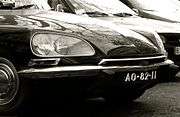 Citroën DS (1967) "Nouveau Visage"
Citroën DS (1967) "Nouveau Visage"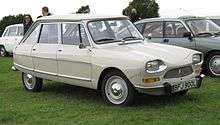 Citroën Ami 8 (1969)
Citroën Ami 8 (1969).jpg) Citroën SM (1970) 1972 Motor Trend Car of the Year.
Citroën SM (1970) 1972 Motor Trend Car of the Year.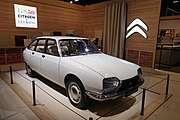 Citroën GS[49] (1970) 1971 European Car of the Year.
Citroën GS[49] (1970) 1971 European Car of the Year. Citroën CX[50] (1974) 1975 European Car of the Year.
Citroën CX[50] (1974) 1975 European Car of the Year.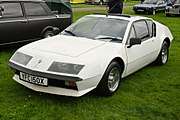 Renault Alpine A310 V6 (1976)
Renault Alpine A310 V6 (1976)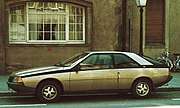 Renault Fuego (1980)
Renault Fuego (1980)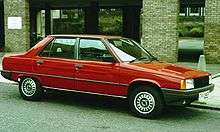 Renault 9[51] (1981) 1982 European Car of the Year.
Renault 9[51] (1981) 1982 European Car of the Year..jpg) Renault 11[52] (1983)
Renault 11[52] (1983)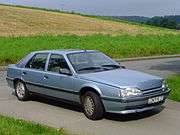 Renault 25[53] (1984)
Renault 25[53] (1984)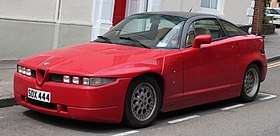 Alfa Romeo SZ[54] (1989)
Alfa Romeo SZ[54] (1989)
References
- Caspers, Markus (26 September 2016). Designing Motion: Automotive Designers 1890 to 1990. Birkhäuser. p. 149. ISBN 978-3035609820.
- Maak, Niklas. "Autopilot #49: Vive la Berline". www.dear-magazin.de.
- Guenzel, Peter (28 October 2017). "Robert Opron". Octane.
- "Robert Opron". leroux.andre.free.fr.
- Böttcher, Gerrit (July–September 2007). "Robert Opron – zum Anlass seines 75 zigsten Geburtstages" [Robert Opron – on the occasion of his 75th birthday] (PDF). Citroën-Clubzeitung. No. 76. Citroën-SM-Club Deutschland e. V. pp. 7–8.
- Siner, Neil. "Robert Opron: The Art of the Automobile". www.influx.co.uk.
- "Livres – Robert Opron, l'automobile et l'art". Archived from the original on 21 December 2018. Retrieved 1 March 2020.
- "Robert Opron: design futuristico" [Robert Opron: futuristic design]. wheels.iconmagazine.it (in Italian). 1 June 2017.
- Parker, Johni (17 August 2014). "Citroën Head of Design Robert Opron was Defiant, Perseverant". petrolicious.com.
- Bird, Guy (3 October 2017). "Robert Opron Giant of French car design interviewed". drive-my.com.
- González, Ignacio Ferreiro (12 September 2017). "Regreso al futuro" [Back to the future]. Extra Voz – Suplemento De Motor. La Voz de Galicia.
- Lawson, Bryan (14 December 2005). How Designers Think – The Design Process Demystified (PDF) (4 ed.). Architectural Press. p. 256. ISBN 978-0-7506-6077-8.
- "Opron 50 ans de style – 11 mai 2002" [Opron – 50 years of style - 11 May 2002]. Archived from the original on 16 February 2013. Retrieved 27 February 2020.
- "Cars of Robert Opron" (PDF). www.carlisleevents.com.
- Pijlman, Peter I. (February 2002). "Citroën – the chamber orchestra". Robert Opron – l’Automobile et l’Art (PDF). Netherlands: Sagitta Productions. ISBN 978-9051790245. Archived from the original (PDF) on 28 December 2003. Retrieved 28 February 2020.
- Cole, Lance (1 August 2014). Citroën: The Complete Story (PDF). The Crowood Press UK. ISBN 978-1847976598.
- Renault, Alex (22 October 2015). "Simca Fulgur (1958)". lautomobileancienne.com.
- "Designers : Robert Opron, le designer français le plus talentueux et prolifique" [Designers: Robert Opron, the most talented and prolific French designer]. absolutelycars.wordpress.com. 22 February 2020.
- Tatra87 (7 May 2019). "Automotive History: French Deadly Sins (M.C. Escher Edition, Part 1): Fiat + Ford + Chrysler + Rootes = Simca, The Impossible Equation". www.curbsideclassic.com.
- Patrick, Sean (16 November 2014). "Theme : Books – Robert Opron : L'Automobile et l'Art by Peter J Piljman". driventowrite.com.
- "Renault Espace had almost been a Peugeot". amklassiek.nl. 11 August 2015.
- Marsh, Julian (2005). "Citroën G-mini prototype and projet EN101". www.citroenet.org.uk.
- Marsh, Julian (2005). "Citroën Belphégor 350, 370, 450, 480, 600, 700, 800 and 850 trucks". www.citroenet.org.uk.
- "Citroën N et P "Belphegor" : le poids lourd fantôme" [Citroën N and P "Belphegor": the phantom heavyweight]. www.carjager.com. 6 August 2017.
- Ciferri, Luca (7 May 2001). "Who designed important cars in history?". europe.autonews.com.
- Bonnaud, Christophe (19 June 2019). "ENGLISH – Archives : the surprising GS berlinette from Chapron". lignesauto.fr.
- "Model — Pininfarina BMC 1800 Berlina Aerodinamica 1967". www.coachbuild.com. 29 July 2017.
- "Design Match for the Citroën CX?". citroenvie.com. 3 January 2018.
- Robinson, Peter (2002). "The Pininfarina 1800". www.landcrab.net.
- "The 17-year "Stopgap": Citroën Ami 8". oldmotors.net. 28 August 2019.
- Marsh, Julian (1996). "Projet M – Citroën Ami 6 prototypes and Ami 8". www.citroenet.org.uk.
- Petrány, Máté (31 January 2020). "The majestic Citroën SM celebrates its 50th anniversary in Paris". www.hagerty.com.
- "DS Automobiles Celebrates the SM's Jubilee at Retromobile". 3 February 2020.
- Marsh, Julian; Cass, Brian (2003). "Projet L". www.citroenet.org.uk.
- "Alpine: A Brief History". bringatrailer.com. 9 April 2018.
- Bonnaud, Christophe (6 February 2019). "Quand Renault inventait la Panda… avant Giugiaro !" [When Renault invented the Panda ... before Giugiaro!] (in French).
- "Gaston Juchet Designer" (in French). 14 June 2016.
- LaChance, David (May 2010). "1982-1985 Renault Fuego". Hemmings Motor News.
- Greison, Jakob (18 January 2018). "1980 Renault Alpine A310". www.bonhams.com.
- "AMC and Renault's Alliance". oldmotors.net. 27 May 2019.
- "Gaston Juchet : talentueux et modeste" [Gaston Juchet: talented and modest]. renaultconcepts.online.fr. 28 April 2017.
- "Giorgetto Giugiaro". leroux.andre.free.fr (in French).
- Bonnaud, Christophe (3 December 2019). "ENGLISH – X29 Project: when Gandini wanted to seduce Robert Opron".
- "Renault Magnum – Conceptual thinking". losangemagazine.com. December 2020 – February 2020.
- "Renault Premier – The First, the Last". losangemagazine.com. March–May 2018.
- Golseth, Andrew (11 October 2017). "1990 Alfa Romeo SZ ($105,000)". petrolicious.com.
- Classic Car: The Definitive Visual History. DK. 13 September 2016. pp. 292–293. ISBN 978-1465453396.
- Meunier, Nicolas (19 September 2013). "Dué II : la voiture sans permis low-cost se renouvelle" [Dué II: the low-cost license-free car is renewed]. www.challenges.fr.
- Cole, Lance (27 February 2005). "Citroen GS". The Independent. Retrieved 1 April 2012.
- "Unique Citroens on show". Classic & Performance Car. 5 October 2009. Archived from the original on 12 December 2009. Retrieved 1 April 2012.
- "Renault: A look to the past". Renault Freaks Online. Archived from the original on 22 April 2009.
- "Histoire". www.renault-9-11.fr (in French).
- "1984-1992 Renault 25". Classic & Performance Car. Archived from the original on 18 October 2013. Retrieved 1 April 2012.
- Perkins, Chris (25 October 2017). "You Must Buy This 1991 Alfa Romeo SZ". www.roadandtrack.com.
Further reading
- Pijlman, Peter I. (February 2002). Robert Opron – l’Automobile et l’Art. Netherlands: Sagitta Productions. ISBN 978-9051790245.
- Cotti, Camillo. "INTERVISTA A ROBERT OPRON" [Interview with Robert Opron] (PDF). SpaCXzio (in Italian). No. tre. CX Club Italia. pp. 10–15.
- "Robert Opron De Fulgur à Fuego" [Robert Opron – From Fulgur to Fuego]. Retroviseur. No. 95. July 1996.
- "Robert Opron – Styliste". Retroviseur. No. 248. September 2009.